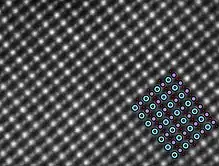
Lanthanum strontium manganite (LSM or LSMO) is an oxide ceramic material with the general formula La1−xSrxMnO3, where x describes the doping level.
It has a perovskite-based crystal structure, which has the general form ABO3. In the crystal, the 'A' sites are occupied by lanthanum and strontium atoms, and the 'B' sites are occupied by the smaller manganese atoms. In other words, the material consists of lanthanum manganite with some of the lanthanum atoms substitutionally doped with strontium atoms. The strontium (valence 2+) doping on lanthanum (valence 3+) introduces extra holes in the valence band and thus increases electronic conductivity.
Depending on the x value in La1−xSrxMnO3, the unit cell of LSMO can be rhombohedral, cubic, or hexagonal. This change in the unit cell is explained on the basis of the Goldschmidt tolerance factor for perovskites. The change in the oxidation state of the Mn cation in LSMO can be readily observed through the position of the XPS peak for the Mn 2p3/2 orbital, and the interesting ferromagnetic ordering obtained when x=0.5 and 0.7 in the La1−xSrxMnO3.[1]
LSM has a rich electronic phase diagram, including a doping-dependent metal-insulator transition, paramagnetism and ferromagnetism.[2] The existence of a Griffith phase has been reported as well.[3][4]
LSM is black in color and has a density of approximately 6.5 g/cm3.[5] The actual density will vary depending on the processing method and actual stoichiometry. LSM is primarily an electronic conductor, with transference number close to 1.
This material is commonly used as a cathode material in commercially produced solid oxide fuel cells (SOFCs) because it has a high electrical conductivity at higher temperatures, and its thermal expansion coefficient is well matched with yttria-stabilized zirconia (YSZ), a common material for SOFC electrolytes.
In research, LSM is one of the perovskite manganites that show the colossal magnetoresistance (CMR) effect,[6] and is also an observed half-metal for compositions around x=0.3.[7]
LSM behaves like a half-metal, suggesting its possible use in spintronics. It displays a colossal magnetoresistance effect. Above its Curie temperature (about 350 K) Jahn-Teller polarons are formed; the material's ability to conduct electricity depends on the presence of the polarons.[8]
See also
References
- ↑
J. Ortiz, L. Gracia, F. Cancino, U. Pal; et al. (2020). "Particle dispersion and lattice distortion induced magnetic behavior of La1−xSrxMnO3 perovskite nanoparticles grown by salt-assisted solid-state synthesis". Materials Chemistry and Physics. 246: 122834. doi:10.1016/j.matchemphys.2020.122834. S2CID 213205110.
{{cite journal}}: CS1 maint: multiple names: authors list (link) - ↑ Urushibara A, Moritomo Y, Arima T, Asamitsu A, Kido G, Tokura Y (1995). "Insulator-metal transition and giant magnetoresistance in La1−xSrxMnO3". Physical Review B. 51 (20): 14103–14109. Bibcode:1995PhRvB..5114103U. doi:10.1103/PhysRevB.51.14103. PMID 9978336.
- ↑ Deisenhofer J, Braak D, Krug von Nidda HA, Hemberger J, Eremina RM, Ivanshin VA, et al. (2005). "Observation of a Griffiths Phase in Paramagnetic La1−xSrxMnO3". Physical Review Letters. 95 (25): 257202. arXiv:cond-mat/0501443. Bibcode:2005PhRvL..95y7202D. doi:10.1103/PhysRevLett.95.257202. PMID 16384501. S2CID 34041326.
- ↑ Dagotto E (2003). Nanoscale Phase Separation and Colossal Magnetoresistance. The Physics of Manganites and Related Compounds. Springer. ISBN 978-3540432456.
- ↑ Armstrong TJ, Virkar AV (2002). "Performance of Solid Oxide Fuel Cells with LSGM-LSM Composite Cathodes". Journal of the Electrochemical Society. 149 (12): A1565. Bibcode:2002JElS..149A1565A. doi:10.1149/1.1517282.
- ↑ Ramirez AP (1997). "Colossal magnetoresistance". J. Phys.: Condens. Matter. 9 (39): 8171–8199. Bibcode:1997JPCM....9.8171R. doi:10.1088/0953-8984/9/39/005. S2CID 250804797.
- ↑ Park JH, et al. (1998). "Direct evidence for a half-metallic ferromagnet". Nature. 392 (6678): 794–796. Bibcode:1998Natur.392..794P. doi:10.1038/33883. S2CID 1233128.
- ↑ "Berkeley Lab View – April 29, 2005". lbl.gov. Retrieved 17 May 2015.